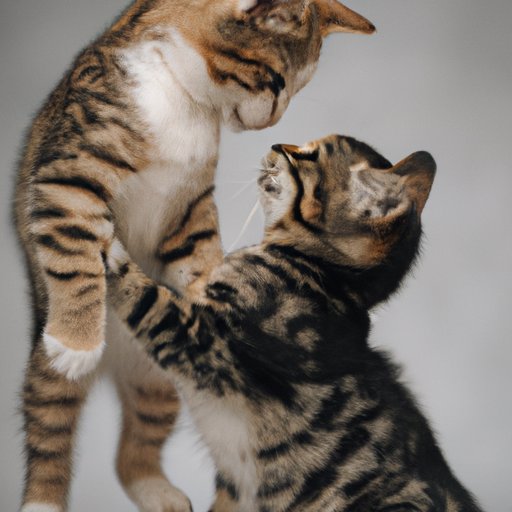
Introduction
Cats have long held a reputation for being mysterious and aloof creatures, but many cat owners would argue that they understand their feline friends on a deeper level. In recent years, research has suggested that cats are more emotionally intelligent than previously thought and may even be able to recognize and respond to human emotions. This article will explore the science behind feline empathy and investigate whether cats really do know when you are sad.
Investigating Feline Empathy: Do Cats Understand Human Emotions?
A study published in the journal Animal Cognition suggested that cats are able to recognize certain human emotions, such as happiness and anger, based on their owners’ facial expressions. Another study published in the journal Current Biology found that cats showed a stronger response to human emotion than to other stimuli, such as food or toys.
While the research is still in its early stages, many cat owners report anecdotal evidence of their cats displaying empathy. For example, some cats have been known to nuzzle and lick their owners’ faces when they are upset or lay next to them when they are feeling sad or stressed.
The Purrfect Comfort: How Cats Can Help Soothe Sadness and Stress
Cats are known for their comforting purrs, which have been shown to have a calming effect on humans. The frequency of a cat’s purr, which typically falls between 25 and 150 hertz, has been shown to have a therapeutic effect on human muscles and bones, helping to reduce pain and promote healing.
In addition to their purring, cats’ physical presence can also be a source of comfort. Many cat owners report feeling less stressed and anxious when they snuggle with their cats.
Tips for using your cat to cope with sadness and stress:
- Take a break from work or other stressors to play with your cat
- Cuddle up with your cat and watch a movie or read a book
- Take a nap with your cat
- Speak to your cat as if you were talking to a close friend or therapist
It’s All in the Tail: Reading Feline Body Language for Signs of Emotional Intelligence
While cats may not be able to communicate their emotions verbally, their body language can provide valuable clues about how they are feeling. Paying attention to your cat’s tail can be particularly helpful in understanding their mood.
Some tail positions that may indicate your cat is feeling content and relaxed include:
- Upright with the tip slightly bent
- Curved around their own body
- Puffed up while the cat remains relaxed
Conversely, some tail positions that may suggest your cat is feeling nervous or agitated include:
- Held low and twitching
- Puffed up while the cat appears tense or frightened
The Science of Snuggles: How Physical Touch Can Benefit Both You and Your Cat
Physical touch has been shown to have a variety of benefits for both humans and animals. Petting a cat, for example, can help to reduce stress, lower blood pressure, and promote the release of feel-good hormones such as oxytocin and serotonin in both the human and the cat.
Some ways to use physical touch to improve your bond with your cat and manage your emotions might include:
- Grooming your cat regularly
- Playing with your cat using toys that encourage physical contact, such as feather wands or laser pointers
- Hugging or cuddling up with your cat
From Lion to Lap Cat: Exploring the Evolution of Feline-Human Relationships
Cats have been domesticated for thousands of years and have evolved alongside humans to become more attuned to our emotions and behavior. Unlike dogs, which are bred for specific functions like hunting or herding, cats were domesticated primarily for their companionship and ability to control pests.
As a result of their close relationship with humans, cats have become more social and communicative and are often seen as members of the family. The development of the emotional bond between cats and humans is likely to continue as we understand more about feline behavior and feline-human interactions.
Training Your Cat to be an Emotional Support Animal: Tips and Tricks for Creating a Bond That Benefits Your Mental Health
While dogs are the most commonly recognized emotional support animals (ESAs), cats can also provide valuable emotional support for their owners. ESAs are defined as animals that provide emotional support to individuals with a mental health condition such as anxiety or depression and do not require specialized training.
Tips for creating a bond with your cat that benefits your mental health may include:
- Setting aside time each day for play and snuggles
- Training your cat to respond to cues such as sitting in your lap when you are feeling anxious
- Consulting with your mental health professional to determine whether an ESA could be helpful for your condition
Cat Breeds That Are Particularly Attuned to Emotions: Which Felines Are Most in Tune with Their Human’s Moods?
While individual cat personalities can vary widely, certain breeds are known for being particularly sensitive and empathetic to their owners’ emotions. Some of the most emotionally intelligent cat breeds include:
- Sphynx
- Ragdoll
- Persian
- Birman
- Siamese
When choosing a cat breed based on your emotional needs, it is important to consider factors such as grooming requirements, energy levels, and temperament to ensure a good match for both you and your cat.
Conclusion
The bond between cats and their owners can be a source of comfort and emotional support, with many cats displaying empathy and a deep understanding of human emotions. By understanding and responding to your cat’s body language and using physical touch and play to strengthen your bond, you can create a mutually beneficial relationship that promotes emotional well-being for both you and your feline friend.




